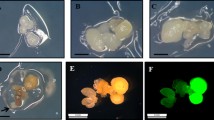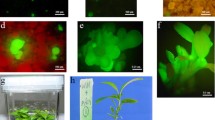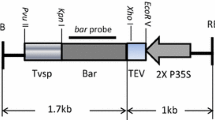Abstract
The bar gene was introduced into the cork oak genome. Cork oak embryogenic masses were transformed using the Agrobacterium strain AGL1 which carried the plasmid pBINUbiBar. This vector harbours the genes, nptII and bar, the latter under control of the maize ubiquitin promoter. The transgenic embryogenic lines were cryopreserved. Varying activities of phosphinothricin acetyl transferase were detected among the lines, which carried 1–4 copies of the insert. Molecular and biochemical assays confirmed the stability and expression of the transgenes 3 months after thawing the cultures. These results demonstrate genetic engineering of herbicide tolerance in Quercus spp.




Similar content being viewed by others
References
Álvarez R, Ordás RJ (2007) Improved genetic transformation protocol for cork oak (Quercus suber L.). Plant Cell Tissue Organ Cult 91:45–52
Álvarez R, Alonso P, Cortizo M, Celestino C, Hernández I, Toribio M, Ordás RJ (2004) Genetic transformation of selected mature cork oak (Quercus suber L.) trees. Plant Cell Rep 23:218–223
An G, Evert PR, Mitra A, Ha SB (1988) Binary vectors. In: Gelvin SB, Schilperoort RA, Verma D-P (eds) Plant molecular biology manual. Kluwer, Dordrecht, pp 1–19
Bernal CJ, Cardillo E (2004) Plagas y enfermedades del alcornocal: La culebra del corcho. Instituto del Corcho, la Madera y el Carbón Vegetal (IPROCOR). Junta de Extremadura, España
Bevan M (1984) Binary Agrobacterium vectors for plant transformation. Nucleic Acids Res 12:8711–8721
Binet M-N, Lepetit M, Weil J-H, Tessier L-H (1991) Analysis of a sunflower polyubiquitin promoter by transient expression. Plant Sci 79:87–94
Cardillo E, Bernal C (2003) Recomendaciones selvícolas para alcornocales afectados por el fuego. Instituto del Corcho, la Madera y el Carbón Vegetal (IPROCOR). Junta de Extremadura, España
Castañón S, Martín-Alonso J, Marín M, Boga J, Alonso P, Parra F, Ordás R (2002) The effect of the promoter on expression of VP60 gene from rabbit hemorrhagic disease virus in potato plants. Plant Sci 162:87–95
Christensen A, Quail P (1996) Ubiquitin promoter-based vectors for high-level expression of selectable and/or screenable marker genes in monocotyledonous plants. Transgenic Res 5:213–218
Christensen AH, Sharrock RA, Quail PH (1992) Maize polyubiquitin genes: genes, structure, thermal perturbation of expression and transcript splicing, and promoter activity following transfer to protoplasts by electroporation. Plant Mol Biol 18:675–689
Church G, Gilbert W (1984) Genomic sequencing. Proc Natl Acad Sci USA 81:1991–1995
De Block M, Botterman J, Vandewiele M, Dockx J, Thoen C, Gosselé V, Rao Movva N, Thompson C, Van Montagu M, Leemans J (1987) Engineering herbicide resistance in plants by expression of a detoxifying enzyme. EMBO J 6:2513–2518
Ditta D, Stanfield S, Corbin D, Helinski D (1980) Broad host range DNA cloning system for gram-negative bacteria: construction of a gene bank of Rhizobium meliloti. Proc Natl Acad Sci USA 77:7347–7351
Duke SO, Powles SB (2008) Glyphosate: a once-in-a-century herbicide. Pest Manag Sci 64:319–325
FAO (2004) Preliminary review of biotechnology in forestry, including genetic modification. Forest genetic resources working paper FGR/59E. Forest Resources Development Service, Forest Resources Division, Rome, Italy
Fernández-Guijarro B, Celestino C, Toribio M (1995) Influence of external factors on secondary embryogenesis and germination in somatic embryos from leaves of Quercus suber L. Plant Cell Tissue Organ Cult 41:99–106
Gelvin SB, Kim S-I (2007) Effect of chromatin upon Agrobacterium T-DNA integration and transgene expression. Biochim Biophys Acta 1769:410–421
Götz W, Dorn E, Ebert K, Leist H, Kocher H (1983) HOE 39866, a new non-selective herbicide: chemical and toxicological properties, mode of action and metabolism. In: Proceedings of the Asian Pacific Weed Science Society, 9th conference
Hamill J, Rounsley S, Spencer A, Todd G, Rhodes M (1990) The use of the polymerase chain reaction to detect specific sequences in transformed plant tissues. In: Nijkamp H, Van der Plas L, Aartijk V (eds) Progress in plant cellular molecular biology. Kluwer, Dordrecht, pp 183–188
Hernández I, Celestino C, Martínez I, Manjón J, Díez J, Fernández-Guijarro B, Toribio M (2001) Cloning mature cork oak (Quercus suber L.) trees by somatic embryogenesis. Melhoramento 37:50–57
Humara J, López M, Ordás RJ (1999a) Transient expression of the uidA gene in Pinus pinea cotyledons: a study of heterologous promoter sequences. Plant Cell Tissue Organ Cult 56:69–78
Humara J, Marín MS, Parra F, Ordás RJ (1999b) Improved efficiency of uidA gene transfer in stone pine (Pinus pinea) cotyledons using a modified binary vector. Can J For Res 29:1627–1632
Joffre R, Rambal S, Ratte JP (1999) The dehesa system of southern Spain and Portugal as a natural ecosystem mimic. Agrofor Syst 45:57–79
Kramer C, DiMaio J, Carswell G, Shillito R (1993) Selection of transformed protoplast-derived Zea mays colonies with phosphinotricin and a novel assay using the pH indicator chlorophenol red. Planta 190:454–458
Lazo GR, Stein PA, Ludwig RA (1991) A DNA transformation-competent Arabidopsis genomic library in Agrobacterium. Biotechnology 9:963–967
Lohar D, Schuller K, Buzas D, Gresshoff P, Stiller J (2001) Transformation of Lotus japonicus using the herbicide resistance bar gene as a selectable marker. J Exp Bot 52:1697–1702
López M, Humara J, Rodríguez R, Ordás RJ (2000) Transient uidA gene expression in electroporated cotyledonary protoplast of Pinus nigra ssp. salzmannii and in bombarded cotyledons. Can J For Res 30:448–455
Luque J, Parladé J, Pera J (2002) Seasonal changes in susceptibility of Quercus suber to Botryosphaeria stevensii and Phytophthora cinnamomi. Plant Pathol 51:338–345
Merkle S, Nairn CJ (2005) Hardwood tree biotechnology. In Vitro Cell Dev Biol Plant 41:602–619
Mulwa RMS, Mwanza LM (2006) Biotechnology approaches to developing herbicide tolerance/selectivity in crops. Afr J Biotechnol 5:396–404
Nehra NS, Becwar MR, Rottmann WH, Pearson L, Chowdhury K, Chang S, Wilde H, Kodrzycki RJ, Zhang C, Gause KC, Parks DW, Hinchee MA (2005) Forest biotechnology: innovative methods, emerging opportunities. In Vitro Cell Dev Biol Plant 41:701–717
Peña L, Séguin A (2001) Recent advances in the genetic transformation of trees. Trends Biotechnol 19:500–506
Robin C, Capron G, Desprez-Loustau M (2001) Root infection by Phytophthora cinnamomi in seedlings of three oak species. Plant Pathol 50:708–716
Sambrook J, Fritsch E, Maniatis T (1989) Molecular cloning: a laboratory manual. Cold Spring Harbor Laboratory Press, Cold Spring Harbor
Toribio M, Celestino C, Molinas M (2005) Cork oak, Quercus suber L. In: Jain S, Gupta P (eds) Protocol for somatic embryogenesis in woody plants. Springer, The Netherlands, pp 445–457
Trieu AT, Harrison MJ (1996) Rapid transformation of Medicago truncatula: regeneration via shoot organogenesis. Plant Cell Rep 16:6–11
Valladares S, Toribio M, Celestino C, Vieitez AM (2004) Cryopreservation of embryogenic cultures from mature Quercus suber trees using vitrification. Cryo Letters 25:177–186
Zaragozá C, Muñoz-Bertomeu J, Arrillaga I (2004) Regeneration of herbicide-tolerant black locust transgenic plants by SAAT. Plant Cell Rep 22:832–838
Acknowledgements
Authors thank Dr. M. Toribio for kindly providing the M10 cork oak embryogenic line and Dr. Kevin Dalton for revising the English language. R. Álvarez was supported by a FICYT research fellowship funded by “Gobierno del Principado de Asturias, Spain”. This work was supported by the “Ministerio de Ciencia y Tecnología de España” (MCT-AGL-2002-00867 and MEC-AGL-2005-08214).
Author information
Authors and Affiliations
Corresponding authors
Additional information
Rubén Álvarez, Ricardo J. Ordás are contributed equally.
Electronic supplementary material
Below is the link to the electronic supplementary material.
Rights and permissions
About this article
Cite this article
Álvarez, R., Álvarez, J.M., Humara, J.M. et al. Genetic transformation of cork oak (Quercus suber L.) for herbicide resistance. Biotechnol Lett 31, 1477–1483 (2009). https://doi.org/10.1007/s10529-009-0033-2
Received:
Accepted:
Published:
Issue Date:
DOI: https://doi.org/10.1007/s10529-009-0033-2




